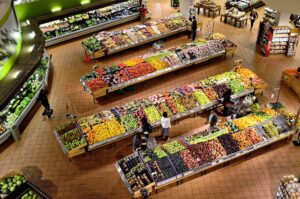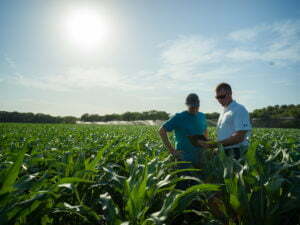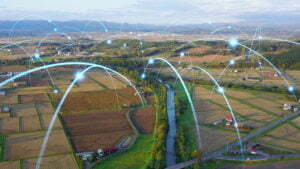New rules to compete and comply.
In agribusiness, data insights define who leads the market and who follows, making it the single greatest catalyst driving competition and change. In 2023, farm data will become more than a competitive issue, as new FDA rules expand traceability requirements and the kind of data that needs to be readily available throughout the supply chain.
To see where food came from, and where it’s going next, requires actionable data. For affected producers, that will likely include records available within 24 hours of an FDA request. The necessary data includes farm maps including the location and name of each field planted with crops on the Food Traceability List including geographic coordinates to identify the growing area. For most food crops, producers already need to keep track of the inputs that have been applied throughout the season, whereas the new FDA rules mainly focus on all events from harvesting onwards.
Yet, record keeping on many farms is still largely a manual process. The majority of software platforms and applications are still not compatible with each other, requiring farmers to upload, download and transfer data between systems and their separate data silos, to understand what’s driving profits and losses. In a world where everything connects, isolated data is a thorn in the side of farmers and a sticking point for the supply chain.
“Farmers must be productive to be profitable, and that’s not possible with isolated solutions,” said Kat Crawford, CEO of Skyward App Company. “From our extensive experience developing leading industry applications, we know for a fact that farmers and advisors with access to unified data are realizing better yields and profits, because they can compare the impact of different scenarios.”
No time to lose
 Unifying farm data is not only a FDA mandate; it is a matter of competitive – and actual – survival. To feed more people on the same amount of land, given historic droughts and other weather extremes, labor shortages, and global market uncertainties will require the ability to use data to unlock new value – from simple improvements like making it easier for farmers to enroll in insurance and order products, to more complicated uses like using farm data to design new seed genetics. Today even the simple cases are limited by incompatible farm data.
Unifying farm data is not only a FDA mandate; it is a matter of competitive – and actual – survival. To feed more people on the same amount of land, given historic droughts and other weather extremes, labor shortages, and global market uncertainties will require the ability to use data to unlock new value – from simple improvements like making it easier for farmers to enroll in insurance and order products, to more complicated uses like using farm data to design new seed genetics. Today even the simple cases are limited by incompatible farm data.
Agribusiness consortiums have worked for years to develop industry data standards, but competing standards, slow adoption, and the exceptional complexity of farm data has left those building with farm data few options to solve the problem of farm data incompatibility. Leaf CEO and co-founder Bailey Stockdale saw the need for a solution that removes the complexity of unifying farm data so companies could focus on their core value proposition.
“Leaf has built a unified API that connects, translates, and normalizes data across all major agriculture platforms including OEM cloud platforms, ERPs, imagery platforms, and more. It removes the need to build multiple integrations, data translation engines, geospatial data association tools, processing workflows, and more so developers can always get data in a consistent pattern and focus on building their core products on top of the data. Our data infrastructure eliminates the upfront work for developers and also the ongoing maintenance they would otherwise have to perform every time an underlying API changes, a new data type becomes available, or a new data source is requested.”
Data is the ground floor for innovation
A unified farm API eliminates the need for agribusinesses to build new software platforms from scratch. Instead, development teams can take unified farm data and combine it with customer-specific information, such as sales, inventory, inputs, orders, pricing, outcomes etc. in developing new applications that increase value for customers. The more data, the fuller the picture, and the greater the opportunity to make discoveries that would otherwise remain hidden.
“Let’s say you want to compare cost efficiencies,” said Nick Elliott, CTO of Skyward App Company. “For example, when is it more optimal to load one bag of seed into your planter and plant on three fields in a row instead of a different field that’s slightly more profitable, because it will cost more in time and wear on equipment.”
“Another example: Let’s say you’re tracking your equipment’s position and pulling in machine data which shows your fuel efficiency,” said Elliott. “Then you look at your yield output and notice that one piece of equipment consistently results in bad yields. If this data was not integrated, you would not be aware that a problem exists.”
The impetus for change
Understanding how data will shape farm decisions will take on more importance as voluminous data is added to meet regulatory requirements and take advantage of emerging market opportunities.

Photo courtesy of Syngenta
To participate in carbon markets, farmers will need to submit large amounts of data to validate the net amount of carbon captured from farm management practices, such as crops planted, nutrients, crop protection, tillage, and cover crops to name a few.
While much of this data is already collected, it is not yet compatible, scalable, or easy to measure. Monitoring, reporting, and verification (MFV) platforms will require large amounts of data to document stewardship, including historical data to establish a baseline for carbon credits.
The FDA’s new traceability rules will impose new data requirements for affected farmers and their downstream supply chains, but the added burden is also an impetus for change. The 24-hour turnaround for data following a food safety incident is likely to accelerate the transition from paper logs to digital record keeping and automate tracking of chemical inputs. The new rule, by necessity, will expedite the integration of supply chain data.
All these new data requirements mean massive changes for farmers. They will need technical help to navigate new requirements, creating an opportunity for tech-savvy advisors and agribusiness partners to start or strengthen relationships.
Data strategy is a process, not a sprint
If you feel overwhelmed by data, you are in good company. The proliferation of agribusiness platforms and applications has made data the Holy Grail and Achilles heel of agriculture. Virtually every agribusiness has millions if not hundreds of millions of records in multiple systems, needed by multiple stakeholders across departments and third parties.
Data strategy starts by understanding your data ecosystem and aligning it to business goals. Examine your data to uncover what you have and what you need.
“Start by asking what’s currently collected, what’s not, where is it stored, and where are the gaps,” advised Crawford, Skyward’s CEO. “As an agribusiness, do you understand how and where data flows, or doesn’t? Do you have a data architecture that can grow over time with your business, and are your systems and applications connected to make data usable and profitable?”
Data is useless unless it can be used, analyzed, and shared. Sooner or later, systems and applications must be connected to convert data into a standard, usable format everyone can access. If regulators don’t require traceability and transparency, customers will.
“Connecting a platform or software product to all major equipment manufacturers used to be difficult and time consuming,” says Leaf CEO Bailey Stockdale, “but that is no longer the case.”
“Instead of forcing every company to re-invent the wheel and deal with a plethora of integration partners who all use a different API structure and data format, Leaf has streamlined the process of becoming interoperable for the whole industry. Not sure of the benefits? According to a recent study by Accenture, companies with interoperable technology achieve six times higher revenue growth… Who needs more reasons than that?!”
Now is the time to develop or rethink your data strategy.
Make sure your team has the skills and experience to connect data across systems and applications without duplication, security risks, and privacy breaches, and above all, make sure they know agriculture. The time and money you save using industry experts will help you avoid costly pitfalls and accelerate your strategy for data mapping and integration.
Leaf and Skyward understand what you’re up against. Our expertise and experience developing software and integrating data for agribusiness spans decades.
Need advice?
You can contact Skyward Apps or Leaf to find out how your existing technologies and data infrastructure can be improved to get you ready for the future.


